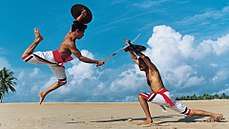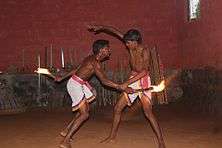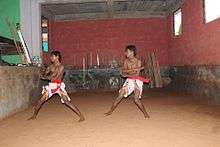Kalaripayattu
 | |
| Focus | Hybrid |
|---|---|
| Hardness | Full-contact, semi-contact |
| Meaning | "Practice in the arts of the battlefield." |
| Part of a series on |
| Indian martial arts |
|---|
 |
| Styles |
|
| Legendary Figures |
| Notable Practitioners |
| Related terms |
Kalaripayattu (sometimes shortened as Kalari) is an Indian martial art and fighting system that originated in Kerala.[1] It is considered to be the oldest martial art in existence, with its origin dating back to the 3rd century BCE.[2][3] Around the 5th century, the Buddhist monk Bodhidharma took Kalaripayattu to East Asia where he taught the technique to Chinese monks.[4] East Asian adaptations of Kalaripayattu led to the creation of the modern martial arts of Karate, Kung Fu, Judo, Jujutsu, Muay Thai etc.[4][5] Kalaripayattu is often called the mother of all martial arts.[5]
Styles
Kalaripayattu has three schools, which are distinguished by their attacking and defensive patterns. They are Arappa Kayy, Pilla Thangi, and Vatten Thiripp.
History
Early written evidence of martial arts is found in Dhanurveda a part of Atharvaveda and Rig Veda and in Sangam literature about Kalarippayattu in the 3rd century BC to the 2nd century AD. The Akananuru and Purananuru describe the use of spears, swords, shields, bows and silambam in the Sangam era. The word kalari appears in the Puram (verses 225, 237, 245, 356) and Akam (verses 34, 231, 293) to describe both a battlefield and combat arena. The word kalari tatt denoted a martial feat, while kalari kozhai meant a coward in war. Each warrior in the Sangam era received regular military training[6] in target practice, horse and elephant riding. They specialized in one or more of the important weapons of the period including the spear (vel), sword (val), shield (kedaham), and bow and arrow (vil ambu). The combat techniques of the Sangam period were the earliest precursors to kalaripayat.[7] References to "Silappadikkaram" in Sangam literature date back to the 2nd century. This referred to the silambam staff which was in great demand with foreign visitors.[8][9]
Elements from the Yoga Sutras of Patanjali, as well as finger movements in the nata dances, were incorporated into the fighting arts.[10] A number of South Asian fighting styles remain closely connected to yoga, dance and performing arts. Some of the choreographed sparring in kalaripayat can be applied to dance[11] and kathakali dancers who knew kalaripayat were believed to be markedly better than other performers. Velakali an art form of the Nayar soldiers from the southern part of kerala combines elements of Kalaripayat to depict ancient battle scenes from the epic Mahabharata. Until recent decades, the chhau dance was performed only by martial artists. Some traditional Indian classical dance schools still incorporate martial arts as part of their exercise regimen.[12]
Kalaripayattu had developed into its present form by the 6th century, during an extended period of warfare between the Chera and Chola dynasties.[10][11] Kalaripayattu includes strikes, kicks, grappling, preset forms, weaponry and healing methods.[11] Regional variants are classified according to geographical position in Kerala; these are the Northern style from Malabar region in north Kerala practiced by the Central style from inner Kerala and the southern style from Thiruvitankoor. Northern kalaripayattu is based on elegant and flexible movements, evasions, jumps and weapons training, while the southern "Adi Murai" style primarily follows the hard impact based techniques with priority on empty hand fighting and pressure point strikes. Both systems make use of internal and external concepts. Some of the flexibility training methods in northern Kalaripayattu are applied in Keralan dance forms[11] and Kathakali dancers who knew martial arts were believed to be markedly better than the other performers. Some traditional Indian dance schools still incorporate kalaripayattu as part of their exercise regimen.
Siddhar Agastya is regarded as the founder and patron saint of southern kalaripayat, silambam and varmam -an ancient science of healing using varmam points for varied diseases.[11]
Revival
The resurgence of public interest in kalaripayattu began in the 1920s in Thalassery, as part of a wave of rediscovery of the traditional arts throughout south India[11] and continued through the 1970s surge of general worldwide interest in martial arts.[13] It has featured in international and Indian films such as Thacholi Othenan (film) (1964), Aromalunni (1972),Ondanondu Kaladalli (Kannada) (1978),Oru Vadakkan Veeragatha (1989), Asoka (2001), The Myth (2005), The Last Legion (2007), Manasara (2010), Urumi (film) (2011),7aum Arivu (2011), Commando (2013), Bajirao Mastani (2015), Baaghi (2016), Veeram (2016), Padmaavat (2018), Kayamkulam Kochunni (2018 film). For more movies featuring kalaripayattu refer Kalarippayattu films.
Techniques

Kalaripayattu techniques are a combination of steps (Chuvadu) and postures (Vadivu). Chuvadu literally means ‘steps’, the basic steps of the martial arts. Vadivu literally means ‘postures’ or stances are the basic characteristics of Kalaripayattu training. Named after animals, they are usually eight in number. Styles differ considerably from one tradition to another. Not only do the names of poses differ, the masters also differ about application and interpretation. Each stance has its own style, power combination, function and effectiveness. These techniques vary from one style to another.[11]




Marmashastram and massage

It is claimed that learned warriors can disable or kill their opponents by merely touching the correct marmam (vital point). This is taught only to the most promising and level-headed persons, to discourage misuse of the technique. Marmashastram stresses on the knowledge of marmam and is also used for marma treatment (marmachikitsa). This system of marma treatment comes under siddha vaidhyam, attributed to the sage Agastya and his disciples. Critics of kalaripayattu have pointed out that the application of marmam techniques against neutral outsiders has not always produced verifiable results.
The earliest mention of marmam is found in the Rig Veda, where Indra is said to have defeated Vritra by attacking his marmam with a vajra.[14] References to marmam are also found in the Atharva Veda.[15] With numerous other scattered references to vital points in Vedic and epic sources, it is certain that India's early martial artists knew about and practiced attacking or defending vital points.[7] Sushruta (c. 6th century BC) identified and defined 107 vital points of the human body in his Sushruta Samhita.[16] Of these 107 points, 64 were classified as being lethal if properly struck with a fist or stick.[10] Sushruta's work formed the basis of the medical discipline ayurveda, which was taught alongside various Indian martial arts that had an emphasis on vital points, such as varma kalai and marma adi.[10]
As a result of learning about the human body, Indian martial artists became knowledgeable in the field of traditional medicine and massage. Kalaripayattu teachers often provide massages (uzhichil) with medicinal oils to their students in order to increase their physical flexibility or to treat muscle injuries encountered during practice. Such massages are generally termed thirumal and the unique massage given to increase flexibility is known as katcha thirumal. It is said to be as sophisticated as the uzhichil treatment of ayurveda. Kalaripayattu has borrowed extensively from Ayurveda and equally lends to it.
See also
References
- ↑ Zarrilli, Phillip B. (1992). "To Heal and/or To Harm: The Vital Spots (Marmmam/Varmam) in Two South Indian Martial Traditions Part I: Focus on Kerala's Kalarippayattu". Journal of Asian Martial Arts. 1 (1).
- ↑ Deleury, Guy (2005). India: The Rebel Continent. Macmillan. p. 89. ISBN 1403924880.
- ↑ Agarwal, M.K. (2013). The Vedic Core of Human History: And Truth Will Be the Savior. iUniverse. p. 197. ISBN 9781491715956.
- 1 2 Gautier, François (2001). A Western Journalist on India: The Ferengi's Columns,. Har-Anand Publications. ISBN 9788124107959.
Father and founder of Zen Buddhism (called C'han in China), Boddidharma taught the Chinese monks Kalaripayattu, a very ancient Indian martial art, so that they could defend themselves against the frequent attacks of bandits. In time, the monks became famous all over China as experts in bare handed fighting later known as the Shaolin boxing art. The Shaolin temple on one of its walls, a fresco can be seen, showing Indian dark-skinned monks, teaching their lighter-skinned Chinese brothers the art of bare-handed fighting. On this painting are inscribed: "Tenjiku Naranokaku", which means: "the fighting techniques to train the body (which come) from India" ~ Shaolin boxing and Chan' Buddhism travelled from China to japan, through the Ryukyu islands, landing in Okinawa to blossom in the art of the empty hand, or later Karate and then spread into the Japanese mainland as jiu-jiu-fau, judo, Shoringi Kempo, etc.
- 1 2 van der Veere, Arnaud (2012). Muay Thai. Meyer & Meyer Verlag. p. 8. ISBN 9781841263281.
- ↑ Subramanian, N. (1966). Sangam polity. Bombay: Asian Publishing House.
- 1 2 Zarrilli, Phillip B. A South Indian Martial art and the Yoga and Ayurvedic Paradigms. University of Exeter.
- ↑ Raj, J. David Manuel (1977). The Origin and the Historical Development of Silambam Fencing: An Ancient Self-Defence Sport of India. Oregon: College of Health, Physical Education and Recreation, Univ. of Oregon. pp. 44, 50, & 83.
- ↑ Sports Authority of India (1987). Indigenous Games and Martial Arts of India. New Delhi: Sports Authority of India. pp. 91 & 94.
- 1 2 3 4 J. R. Svinth (2002). A Chronological History of the Martial Arts and Combative Sports. Electronic Journals of Martial Arts and Sciences.
- 1 2 3 4 5 6 7 Zarrilli, Phillip B. (1998). When the Body Becomes All Eyes: Paradigms, Discourses and Practices of Power in Kalarippayattu, a South Indian Martial Art. Oxford: Oxford University Press. ISBN 978-0-19563-940-7.
- ↑ Luijendijk, D.H. (2008) Kalarippayat: The Essence and Structure of an Indian Martial Art, Oprat, ISBN 978-1-4092-2626-0
- ↑ Zarrilli 1992
- ↑ Mariana Fedorova (1990). Die Marmantheorie in der klassischen indischen Medizin.
- ↑ Subhash Ranade (1993). Natural Healing Through Ayurveda (p. 161). Passage Press. Utah USA.
- ↑ G. D. Singhal, L. V. Guru (1973). Anatomical and Obstetrical Considerations in Ancient Indian Surgery Based on Sarira-Sthana of Susruta Samhita.
Further reading
- Balakrsnan, Pi (1995) Kalarippayattu: The ancient martial art of Kerala, C.V. Govindankutty Nair Gurukka 1995, ASIN B0006F9ONS
- Denaud, Patrick (1996) Kalaripayat, Budostore, ISBN 2-908580-62-4
- Elgood, Robert (2005) Hindu Arms and Ritual: Arms and Armour from India 1400-1865, Eburon Publishers, ISBN 90-5972-020-2
- Zarrilli, Phillip B. (1992) "To Heal and/or To Harm: The Vital Spots in Two South Indian Martial Traditions"
- Zarrilli, Phillip B. (1993) "Actualizing Power and Crafting a Self in Kalarippayattu", Journal of Asian Martial Arts
External links
| Wikimedia Commons has media related to Kalarippayattu. |
- Kalaripayattu: The First Martial Art
- Kalarippayattu - one of the oldest martial arts, Government of Kerala website